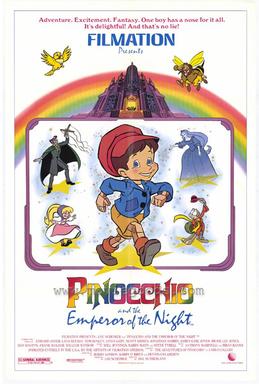 More scary eighties kid cinema, this one an animated rethink of PINOCCHIO crossed with SOMETHING WICKED THIS WAY COMES. It’s not a good movie by any means, but it is a dark and undeniably strikingly one.
More scary eighties kid cinema, this one an animated rethink of PINOCCHIO crossed with SOMETHING WICKED THIS WAY COMES. It’s not a good movie by any means, but it is a dark and undeniably strikingly one.
Weird variants on PINOCCHIO abound, from the cartoon PINOCCHIO IN OUTER SPACE (1965) to THE EROTIC ADVENTURES OF PINOCCHIO (1971) and the Japanese PINOCCHIO 964 (1991). PINOCCHIO AND THE EMPEROR OF THE NIGHT followed on the heels of the George Lucas backed TWICE UPON A TIME (1983), Disney’s BLACK CAULDRON (1985) and the claymation ADVENTURES OF MARK TWAIN (1985), all examples of dark-hued eighties-era animated features that flopped primarily because they didn’t follow the standard kid movie formula.
This film was created by the late Filmation, the animation outfit whose other efforts include the STAR TREK animated series of the seventies and HE-MAN AND THE MASTERS OF UNIVERSE during the eighties. It was distributed, unfortunately, by the late New World Pictures, who fumbled the film’s theatrical and home video release; it has yet to be (legally) released on DVD, and probably never will.
This story begins a year after Pinocchio, still living with his father/creator Geppetto, has been turned from a puppet into a real boy–albeit one whose nose still grows when he doesn’t tell the truth. For Pinocchio’s first birthday the fabled Blue Fairy appears, warning that if Pinocchio takes his freedom for granted he’s in danger of being turned back into a puppet.
Around this time a scary carnival turns up in Pinocchio’s neighborhood, run by the shadowy Puppetino in the service of the Emperor of the Night, a.k.a. Satan. Pinocchio heads to the carnival, where he falls for a marionette singer named Twinkle. Puppetino uses Twinkle to lure Pinocchio into his inner sanctum, where he’s turned back into a puppet and left to molder in a dark puppet room.
Pinocchio is rescued by a new friend, a glowworm named Willakers, and a fortuitous reappearance by the Blue Fairy, who turns Pinocchio back into a flesh-and-blood boy. Pinocchio resolves to be more responsible, and so goes in search of Geppetto’s cherished jewel box, which has been stolen by Puppetino–who in the meantime has put a bounty out on Pinocchio’s head!
That bounty is pursued by Igor, a talking bear, and Scalliwag, a monkey, who snatch Pinocchio and take him on a schooner ride. They end up sucked into the bow of a giant black ship known as the Empire of the Night. Inside the EotN a skuzzy boatman leads Pinocchio to “The Land Where Dreams Come True,” a hallucinatory dance hall where Pinocchio imbibes a greenish drink and performs a song and dance number amid dancing girl silhouettes.
Temptation is what the Emperor of the Night uses to gain control, and Pinocchio is his latest victim. But he’s determined to fight back, and relinquish Geppetto’s jewel box in the process!
As dark and creepy as this film is, director Hal Sutherland does frequently try and soften the proceedings with goofy music and whiz-bang sound effects. The film also contains its share of standard kid movie nonsense: Pinocchio’s goofy insect sidekicks Grumblebee and Willakers (voiced by Don Knotts and Jonathan Harris) impart the requisite cutesy whimsy, while the Blue Fairy provides the sappiness–and also the dreary music numbers it seems every animated kid’s movie requires, with tunes so instantly forgettable they’re not even worth making fun of.
What resonates are the scary sequences, particularly the early scene in which Pinocchio is turned back into a puppet, which for sheer nightmarishness actually outdoes the original PINOCCHIO’S famous donkey transformation. The hallucinatory sequence wherein Pinocchio trips out on an imaginary dance floor is even better, being an eye-popping frenzy of motion and color.
The hand drawn animation isn’t bad, with a classical style familiar to anyone who watched cartoons back in the seventies and eighties (Filmation, after all, was responsible for quite a few of those cartoons). The animators are at their most inspired in the horrific sequences, which have a verisimilitude lacking in the film overall (unlike much of the rest of the animation, the backgrounds in the Emperor’s realm actually move). The multi-armed Emperor of the Night is a particularly wondrous creation, framed more often than not over arresting infernal backdrops and imposingly voiced by none other than James Earl Jones.
Beyond all that, however, the film isn’t much. The story is a hodgepodge with quite a few details (such as the Blue Fairy’s true identity and the minutiae of Geppetto’s quest to find Pinocchio) that aren’t properly fleshed out, and an unsatisfying ending that, in true Hollywood fashion, closes things out with a big explosion. Had the screenwriters and director worked a little harder on such matters, PINOCCHIO AND THE EMPEROR OF THE NIGHT might be an animated classic rather than the dark-hued curiosity it is.
Vital Statistics
PINOCCHIO AND THE EMPEROR OF THE NIGHT
Filmation Associates/New World Pictures
Director: Hal Sutherland
Producer: Lou Scheimer
Screenplay: Robby London, Barry O’Brien, Dennis O’Flaherty
Editing: Rick Gehr, Jeffrey Patch
Cast (voices): Scott Grimes, Edward Asner, Don Knotts, James Earl Jones, Tom Bosley, Lana Beeson, Linda Gary, Jonathan Harris, Rickie Lee Jones, Frank Welker, William Windom
